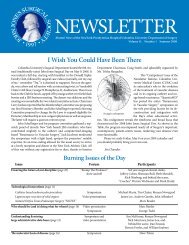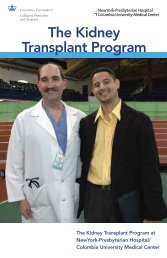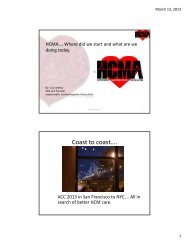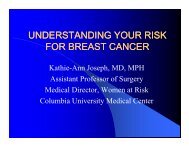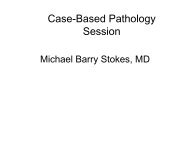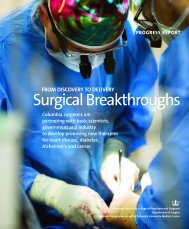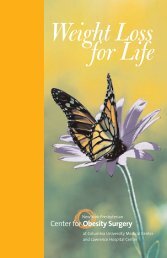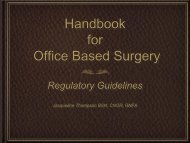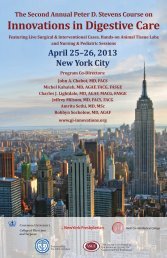NEWSLETTER - Columbia University Department of Surgery
NEWSLETTER - Columbia University Department of Surgery
NEWSLETTER - Columbia University Department of Surgery
Create successful ePaper yourself
Turn your PDF publications into a flip-book with our unique Google optimized e-Paper software.
CUMC’s Plastic <strong>Surgery</strong> Division and Webster’s Library<br />
E. Hanson Lenyoun and Stephen E. Novak<br />
E. Hanson Lenyoun, PGY-1<br />
resident in surgery.<br />
In July or August <strong>of</strong> 1927, Alan<br />
O. Whipple arranged an Edward S.<br />
Harkness Fellowship for Webster to<br />
study with Vilray Papin Blair (1871-<br />
1955) and James Barrett Brown<br />
(1899-1971) at Washington <strong>University</strong>’s<br />
Barnes Hospital in St. Louis,<br />
MO. 1 This allowed Webster to ease<br />
back into clinical practice and coincided<br />
with the time remaining before<br />
<strong>Columbia</strong> Presbyterian’s new medical<br />
center would open on March 16,<br />
1928. Vilray Blair had published Sur-<br />
gery and Diseases <strong>of</strong> the Mouth and Jaw in 1912, which served as the<br />
“bible” for US Army surgeon-dentist teams that Blair and Robert<br />
Ivy deployed throughout the American Expeditionary Forces in<br />
Europe. 2 Blair returned to the United States after the November 11,<br />
1918 Armistice to form a multidisciplinary team for the care <strong>of</strong> complex<br />
maxill<strong>of</strong>acial injuries at Walter Reed General Hospital.<br />
When Webster arrived in St. Louis in September 1927, Blair<br />
and Barrett Brown, who had been Blair’s resident, had already established<br />
the first civilian plastic surgery service in the US. Webster<br />
lived in the house staff’s quarters at Barnes Hospital where he could<br />
observe operations but not assist on them, as he could at the three<br />
other hospitals where they operated. 3 Webster spent eight months<br />
in St. Louis making carefully illustrated notes <strong>of</strong> operations and also<br />
worked in their animal laboratory, attempting to grow intestinal<br />
mucosa grafts as implanted tubes in dogs. Webster’s characteristic<br />
ingratiation assured frequent invitations to dine at the Blairs’ home,<br />
as well as their staying in contact through letters and their work in<br />
founding the American Board <strong>of</strong> Plastic <strong>Surgery</strong> (ABPS). After Blair<br />
died, Webster remarked to Blair’s son that his father’s work had done<br />
more to raise the standard <strong>of</strong> plastic surgery in this country to a high<br />
level than any other factor.<br />
Division Building and America’s First<br />
Certified Plastic <strong>Surgery</strong> Residency<br />
Webster returned to New York in April <strong>of</strong> 1928 to be a Surgical<br />
Fellow in Whipple’s department with a salary <strong>of</strong> $1,500 per year.<br />
Whipple’s missionary background showed itself in the miserly salaries<br />
that ran through all academic ranks in his department. Webster<br />
initially cared for plastic and non-plastic surgical patients as he built<br />
up his reputation, which was easier to do in the Vanderbilt outpatient<br />
clinic than with in-patients. Webster estimated that the clinic served<br />
at least 1,000 patients in its first two years, which rose to over 2,000<br />
visits per year in less than a decade. He began to receive consults<br />
from Babies and Sloane Hospitals and started seeing private patients<br />
in the Harkness Pavilion. As was true for all fulltime faculty, his fees<br />
went to <strong>Columbia</strong> <strong>University</strong>, but in his case they went into a special<br />
Plastic <strong>Surgery</strong> Fund to develop a division and support salaries for a<br />
research assistant and an artist, as well as for equipment.<br />
Webster was appointed to Assistant Attending Surgeon, with<br />
no salary, in 1931. His practice had grown to a volume that allowed<br />
him to devote all <strong>of</strong> his time to plastic surgery. This was also true<br />
for surgeons in many centers throughout the country, which led to<br />
John Jones Surgical Society Volume 13, Number 2 Winter 2010<br />
the founding <strong>of</strong> the ABPS in 1937. 4 The initial goals <strong>of</strong> the Board<br />
were to establish requirements for certification and formulate training<br />
guidelines. Webster was ahead <strong>of</strong> the curve: His first trainee,<br />
Thomas William Stevenson, Jr. (1904-1958) had been a Senior Fellow<br />
in plastic surgery in 1933 and was appointed in the next year<br />
to Assistant Attending Surgeon. Radford C. Tanzer (1905-2003), a<br />
Harvard Medical School graduate and Strong Memorial trained surgeon<br />
became Webster’s second Senior Fellow in 1936. He went on to<br />
pioneer ear reconstruction,<br />
originating his<br />
own classification <strong>of</strong><br />
microtia, do extensive<br />
work in hand surgery<br />
and thumb reconstruction,<br />
and was one <strong>of</strong> the<br />
earliest staff members<br />
<strong>of</strong> Dartmouth’s Mary<br />
Hitchcock Hospital. 5,6<br />
Radford C. Tanzer in 1961, center and seated.<br />
Webster’s two-year<br />
training program became<br />
the first ABPS certified<br />
residency in 1938<br />
with S. Milton Dupertuis<br />
as its first <strong>of</strong>ficial<br />
6<br />
S. Milton Dupertuis examining a patient with a cleft lip repair in 1958. 8<br />
resident, to be followed by John Stage Davis’ son, W. Bowdoin Davis.<br />
Dupertuis 7 distinguished himself from Webster and many <strong>of</strong> Webster’s<br />
trainees by doing interesting bench research on the growth <strong>of</strong><br />
cartilage transplants in rabbits. He started his own plastic surgery<br />
residency program at the <strong>University</strong> <strong>of</strong> Pittsburgh in 1948. 8 Hand<br />
surgeon Robert Chase was one <strong>of</strong> his residents. Dupertuis died at age<br />
53 in 1959 from a myocardial infarction. 9<br />
The ABPS required two years <strong>of</strong> training in surgery, or its<br />
equivalent, beyond internship to be eligible for training in plastic<br />
15



